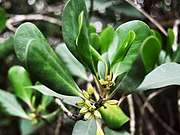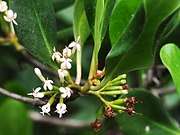Scyphiphora
Scyphiphora is a monotypic genus of flowering plants in the family Rubiaceae. It is the only genus in the tribe Scyphiphoreae. The genus contains only one species, viz. Scyphiphora hydrophylacea, which has a large distribution range from India, to tropical Asia and the western Pacific.[1] It is a shrub of about 3 m (10 ft) and is often found in mangrove forests or sandy beaches. Its local common names include chengam in Malaysia, ngam in Thailand, nilad or sagasa in the Philippines, and côi in Vietnam.[2]
| Scyphiphora | |
|---|---|
 | |
| Scyphiphora hydrophylacea | |
| Scientific classification | |
| Kingdom: | Plantae |
| Clade: | Tracheophytes |
| Clade: | Angiosperms |
| Clade: | Eudicots |
| Clade: | Asterids |
| Order: | Gentianales |
| Family: | Rubiaceae |
| Subfamily: | Ixoroideae |
| Tribe: | Scyphiphoreae |
| Genus: | Scyphiphora C.F.Gaertn. |
| Species: | S. hydrophylacea |
| Binomial name | |
| Scyphiphora hydrophylacea | |
| Synonyms | |
| |
Description


Its leaves are opposite. The leaf blades are broad and drop-shaped. Its terminal buds and young leaves are coated with a varnish-like substance. The flowers are tubular and have four white lobes that are tinged pink. They are arranged in dense clusters. The fruits are elliptic and deeply ridged, becoming light brown and buoyant when ripe.
Uses
Its dark brown wood can be used to craft small objects. Leaf extracts are known to be helpful for stomach aches.[3] The flowers can be used as a cleansing or whitening laundry agent.
Culture
One popular — but antiquated and less linguistically plausible — etymology for Manila, the capital city of the Philippines, asserts that the city's name derives from this shrub, locally known as nilad. However, from a linguistic perspective it would have been unlikely for native Tagalog speakers to completely drop the final consonant /d/ in nilad to achieve the present native form of the name ("Maynilà").[4]
Chemistry
The plant contains friedelin, syringic acid, isoscopoletin, fraxetol, casuarinondiol and guaiacylglycerol-beta-ferulic acid ether.[5]
References
- "Search results for Scyphiphora". The Plant List. Retrieved 1 March 2016.
- "Scyphiphora hydrophyllacea". Retrieved 20 August 2018.
- "Mangrove flora: Chengam (scyphiphora hydrophyllacea)".
- Baumgartner, Joseph (March 1975). "Manila — Maynilad or Maynila?". Philippine Quarterly of Culture and Society. 3 (1): 52–54. JSTOR 29791188.
- Tao, SH; Gao, GC; Qi, SH; Li, QX; Zhang, S (2009). "[Studies on the chemical constituents of Scyphiphora hydrophyllacea (II)]". Zhong Yao Cai. 32 (5): 712–4. PMID 19771844.